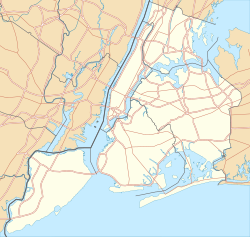Farragut Houses
| Farragut Houses | |
|---|---|
| NYCHA property | |
 |
|
| Coordinates: 40°41′56″N 73°58′54″W / 40.69889°N 73.98167°WCoordinates: 40°41′56″N 73°58′54″W / 40.69889°N 73.98167°W | |
| Country | United States |
| State | New York |
| City | New York City |
| Borough | Brooklyn |
| Area | |
| • Total | 0.026 sq mi (0.07 km2) |
| Population | |
| • Total | 3,272 |
| ZIP codes | 11201 |
| Average household income | $21,000 |
| Website | my |
The Farragut Houses is a public housing project located in the Downtown neighborhood of northwestern Brooklyn, New York City. Bordering the historic Brooklyn Navy Yard, Farragut Houses is a property of New York City Housing Authority (NYCHA). The houses contain 3,272 residents who reside in ten buildings that are each 13 to 14 stories high.
In 1941 there were a total of 341 lots, 27 of which were vacant; of the 314 lots that were extant, 198 consisted of wood structures. Wooden buildings were rarely built after the Great Fire of New York in 1835, and brick became the popular building material around the 1870s, indicating that these framed houses were likely over a century old and were probably built without running water or sometimes even electricity. Prior to demolition, there was still an active neighborhood, with 144 stores that were occupied and 30 unoccupied, as well as 677 apartments, 33 one-family dwellings, and 61 two-family dwellings whose occupants needed to be relocated. There were a total of approximately 970 families to be relocated. The area consisted of 18 smaller blocks divided by roads and small alleyways. Eight streets—Talman Street, Charles Street, High Street, Prospect Street, Dixon Place, Fern Place and Greene Lane—were destroyed by the joining of these smaller blocks when demolition started in 1945. Hudson Avenue was cut off between Front and York Street and diverted over to Navy Street.
In 1949 the stated aproved the Farragut Housing projects fund. The aproval was for $15,087,000. The estimated rental price per room at that time was $5.82.
The three superblocks of the development were completed between 1951 and 1952. The Farragut Houses are located in what used to be a heavily industrial area, very near to the Brooklyn Navy Yard. During wartime, the region was filled with sailors. Restaurants, illegal drinking establishments, tattoo parlors and brothels were packed with people who worked or commuted along the waterfront. Dirty and narrow streets provided a haven for derelict behavior. The Brooklyn Eagle stated of the area in 1945: “... the Brooklyn Bridge will stand out again from the blight which has hemmed it in ... First came the condemnation and the razing of the huge area... a jam-packed section of smoky industry and badly out-worn residences.”
...
Wikipedia



